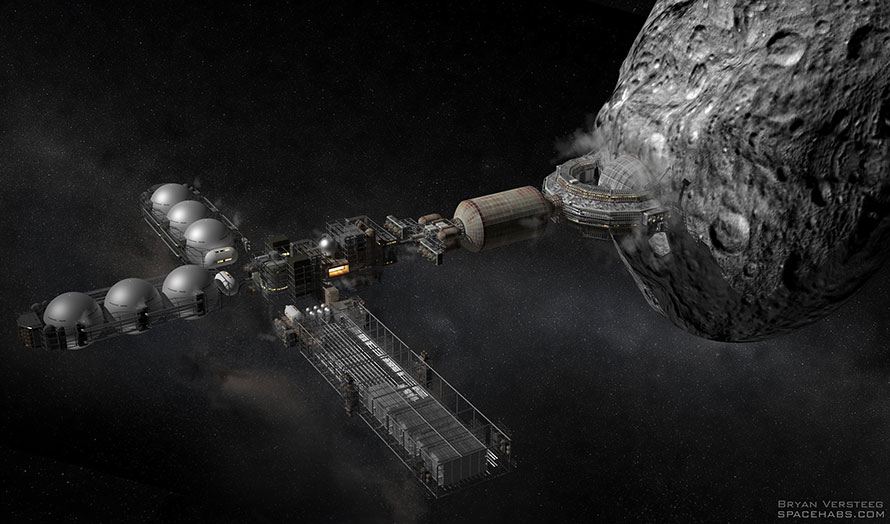 Asteroid smelter. Image: Bryan Versteeg, spacehabs.com
Asteroid smelter. Image: Bryan Versteeg, spacehabs.com
- Roadmap Table of Contents
- Part 1: General Milestones
- Part 2: Utilization and Development of Cislunar Space
- Part 3: To the Moon
- Part 4: To Mars
- Part 5: Asteroid Mining and Orbital Space Settlements (this page)
- Part 6: Additional Expansion and Greater Sustainability of Human Civilization
MILESTONE 26. Robotic Characterization of Asteroids
Remote or robotic characterization of near-Earth (and other) asteroid orbits, compositions and structures.
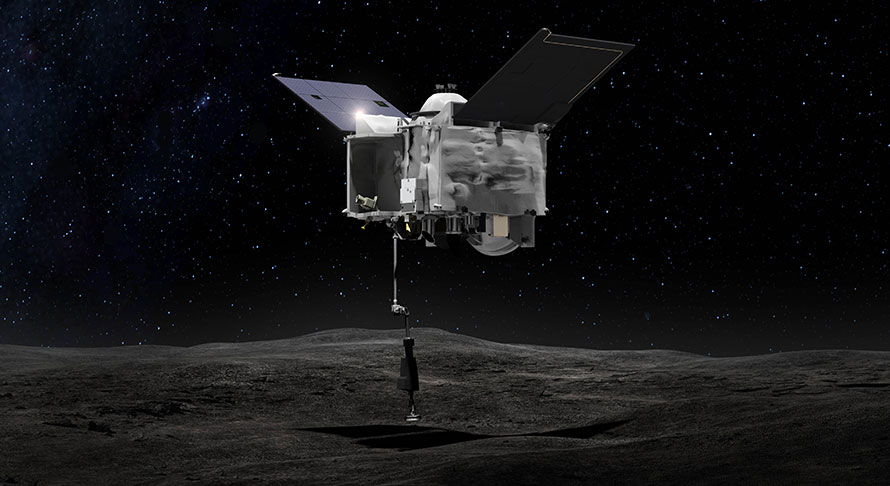 Osiris Rex asteroid sample return mission launched September 2016. Image: NASA
Osiris Rex asteroid sample return mission launched September 2016. Image: NASA
DESCRIPTION
Telescopic observations will initially identify asteroids as Near Earth Objects (NEO’s), Earth threatening NEOs, main belt asteroids and other orbital groupings. Initial robotic missions to NEO asteroids of commercial interest will confirm the size and composition of different types of asteroids as being rocky, metallic or carbonaceous, and identify the actual abundances of minerals on each one. Metallic asteroids contain iron, nickel and platinum group metals, and carbonaceous ones contain carbon compounds and water. The probes will also estimate the structure of the asteroids, as being apparent “rubble piles” of loose fragments, or made of solid, non-fractured rock and metal. Some missions may bring back actual samples of asteroid material for analysis. All this information will assist governments in planning planetary defense against threatening NEOs and will assist mining companies to decide which asteroids to focus on. Earth-threatening NEO’s that are composed of useful minerals could be put on a list of objects to be totally mined away so there is no remaining risk. Radio beacons may be placed on NEO’s to make tracking them easier.
BARRIERS
- Lack of information on the composition and physical structure of individual asteroids.
- Lack of telescopes dedicated to spectral analysis of asteroid composition.
- Lack of telescopes dedicated to finding and tracking small Earth-threatening asteroids.
- Lack of inexpensive robotic probes that can rendezvous with and analyze asteroids.
COMPLETION
The investigation of asteroids will be ongoing as activity expands into the main belt with thousands of objects, so finding a completion point would be difficult. Partial completion would be indicated when sufficient knowledge of asteroids exists to plan planetary defense or actual mining of surveyed asteroids begins.
MILESTONE 27. Utilization of Asteroids
After robotic identification of suitable asteroids, robotic and human crews following to establish mining bases and habitats for transient occupation, and eventually building permanent human settlements nearby.
 The eventual construction of rotating space settlements from minable asteroids. Image: Bryan Versteeg, spacehabs.com
The eventual construction of rotating space settlements from minable asteroids. Image: Bryan Versteeg, spacehabs.com
DESCRIPTION
Asteroids have huge mineral wealth if it can be accessed, including iron, nickel, platinum group metals, other non-volatile materials, and also volatiles like water ice. There are different classes of asteroids with varying amounts of these materials that would be useful both on Earth and in space. That potential value may be the primary driver for asteroid exploration and mining.
As is expected to be the case on the Moon and Mars, deposits of volatiles can be converted to rocket fuel and oxygen, thus enabling further space operations. The metals in asteroids can be refined and turned into construction materials for building large structures in space. Smelting and fabrication of parts from asteroids will require either the development of new techniques for doing this in microgravity, or the use of rotating structures to provide gravity so that existing methods can be used.
The practicality of returning asteroidal materials to Earth or other locations would depend on (1) transport costs, (2) value of the materials as delivered and (3) the extent to which those materials can be separated and purified to reduce the total mass before transport. Asteroid resources may greatly improve life on Earth. Economic return of materials to Earth is expected to involve the use of fuel obtained from asteroid mining.
In time, asteroids will see more permanent rotating habitats created nearby, probably made of asteroid derived materials, and using unprocessed asteroid materials for radiation shielding. These habitats will house either visiting crews or, if there is sufficient mining to be done, permanent occupants. With an appropriate asteroid, these mining stations may go through the same processes of growth as settlements on the Moon and Mars, and evolve into permanent settlements where people will raise their children and live out their lives, as on any far frontier. Proposals have also been made for hollowing out an asteroid and building a rotating space settlement inside it.
The eventual construction and location of rotating space settlements in the orbits of minable asteroids would reduce the materials transport costs of asteroid resources and derived materials for the construction of such settlements. This would create a synergism which should accelerate the asteroid mining industry.
BARRIERS
- Economic barriers (transport costs) to moving asteroidal products to space settlement construction sites and to the Earth and vicinity.
- Lack of knowledge of methods for mining, refining, and fabricating asteroidal products such as building materials in microgravity.
- Lack of detailed planning and design for use of the fabricated building materials to build large space structures.
COMPLETION
This milestone will be considered achieved when asteroid mines and smelters are regularly sending ores or refined products to the Earth, Moon or Mars or are contributing substantial structural mass to rotating space settlements in any location.
MILESTONE 28. Development of Orbital Space Settlements
Orbital “cities in space” built from asteroid or lunar materials.
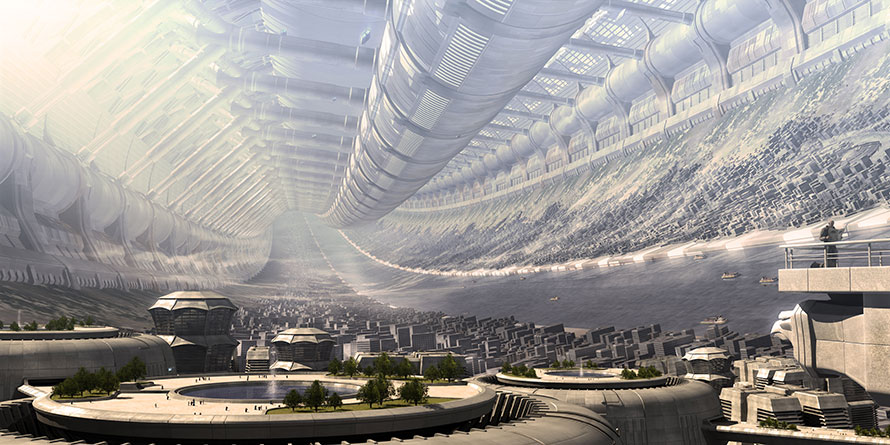 Image: Alexander Preuss
Image: Alexander Preuss
DESCRIPTION
Orbital space settlements are large pressurized structures that constitute cities or villages with residential, commercial and/or governmental functions, built in space from asteroid or lunar materials, where families live. The settlements would rotate to provide artificial gravity.
In 1974, Princeton physicist Gerard O’Neill proposed the construction of orbital space settlements. An orbital settlement (sometimes called an “O’Neill Settlement”) is a giant rotating space structure, large enough and rotating fast enough so that people standing on the inner surface would experience a centrifugal force equivalent to gravity on the surface of the Earth. Thus, children on orbital space settlements would be raised in Earth-normal gravity, which is important for normal bone and muscle development. Three proposed types of orbital settlements are Bernal Spheres (and a variation called Kalpana), Stanford Tori and O’Neill Cylinders.
Shapes
Since orbital space settlements must rotate, only a few basic shapes work well: sphere, torus, cylinder, disk, or some combination. Current materials are strong enough for habitats many kilometers in extent, big enough for a moderately large city. The inner surface of the hull is real estate, i.e., land on which crops could be grown and homes and businesses could be constructed. While the outer hull will experience one gravity, interior structures can be positioned for fractional gravity, and even zero gravity at the axis of rotation. People and their families can live there indefinitely, in communities ranging in size from villages to cities which have their own internal economies as well as external imports and exports.
Radiation Shielding
The Equatorial Low Earth Orbit (ELEO) settlements discussed in Milestone 16, which can act as precursors for later orbital settlements, use the Earth’s geomagnetic field to shield them from space radiation. All other settlements would need to use extensive radiation shielding.
Unlike Lunar or Martian surface settlements, radiation shielding is required on all sides, so roughly twice as much shielding mass is necessary. Shielding can consist of a substantial mass of asteroidal rubble, water, waste material, or some other mass.
Location Options
Orbital settlements could be built in, or moved to, a variety of orbits, including Earth, solar or other orbits, including special locations such as Lagrange points. Most of these orbits would be selected to have continuous solar energy available. The choice of orbit may be driven by access to materials, such as sites co-orbiting near an asteroid mine. For use in cislunar space, lunar material could be launched into space using electromagnetic launchers (mass drivers). Material mined from an asteroid could be utilized either in an orbit close to the asteroid or moved to some other desired location. There are thousands of candidate asteroids among the Near Earth Objects, some requiring less energy to reach than the Moon.
Eventually such cities in space could be located throughout the solar system, orbiting around planets or moons, co-orbiting with asteroids, at Lagrange points, or in solar orbit. These settlements may be very different from each other, each reflecting the particular tastes and cultures of those who built, financed and settled it. Such diversity could provide a new flowering of human creativity. The result would also be to disperse humankind throughout the solar system, enabling survival even if some disaster were to befall the Earth.
Economic Considerations
Orbital settlements may be built by private companies, governments, or consortiums. It will be financially possible to build them only when the cost of construction and support is less than the expected value of the settlement, financial or otherwise.
The Potential Scale of Orbital Settlement
Orbital settlements could be built in virtually unlimited numbers. NASA Publication SP-413 (Space Settlements: A Design Study) states: “If the asteroids are ultimately used as the material resource for the building of new colonies, and … assuming 13 km of total area per person, it appears that space habitats might be constructed that would provide new lands with a total area some 3,000 times that of the Earth.”
COMPONENTS (required capacities)
Habitats in space beyond Low Earth Orbit designed as space settlements must be able to:
- Provide redundant life support systems for the residents that will last for many decades.
- Store sufficient reserves of food and water for the residents, recycle water and grow food.
- Provide a high level of protection and redundancy against loss of air pressure accidents.
- Protect residents against constant cosmic radiation (heavy, fast nuclei from outside the solar system) to a level consistent with the presence of children and pregnant women.
- Protect against intermittent radiation from solar mass ejections and general solar radiation to a level consistent with the presence of families and children.
- Provide artificial (centrifugal) gravity with a sufficient level of gravity to maintain health.
- Provide for permanent residency by making the habitats suitable (large enough, etc,) for comfortable living.
- Provide employment and recreation for the residents.
BARRIERS
- Lack of asteroidal or lunar-derived materials and parts in space for construction of orbital settlements.
- Lack of detailed planning, design and methods for creation of orbital space settlements, including use of materials to build large, pressurized, rotating structures in space.
- Lack of immediate economic incentive to work toward orbital settlement construction.
- Inadequate understanding of human physical adaptation and the psychology of individuals and large groups of people living in space.
- Lack of information on all phases of the cost to construct orbital space settlements.
- Planetary chauvinism: the idea that people should only live on planetary surfaces.
COMPLETION
This milestone can be considered achieved when a rotating space settlement built primarily from non-terrestrial materials has a population of at least 1000 including families and children. Another milestone will be achieved when the total population in orbital space settlements exceeds the population on Earth.
ORBITAL SPACE SETTLEMENT DESIGNS (click for larger image)
Kalpana One:
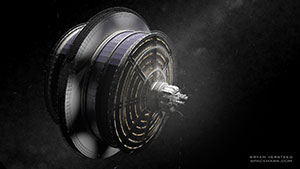

Diameter: 1/3 mile – Population: 3,000
(Bryan Versteeg, spacehabs.com)
Bernal Sphere:
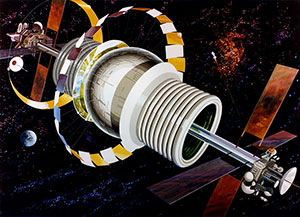
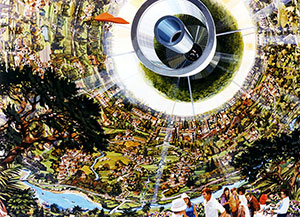
Diameter: 1/3 mile – Population: 10,000
(Rick Guidice, NASA)
Stanford Torus:

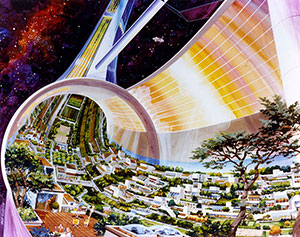
Diameter: 1 mile – Population: 10,000
(Don Davis, Rick Guidice, NASA)
O’Neill Cylinder:
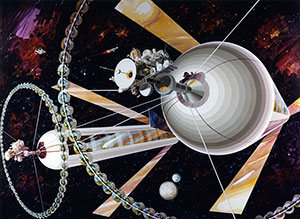
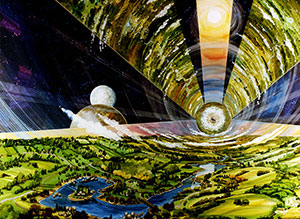
Diameter: 4 miles – Population: over a million
(Rick Guidice, NASA)







